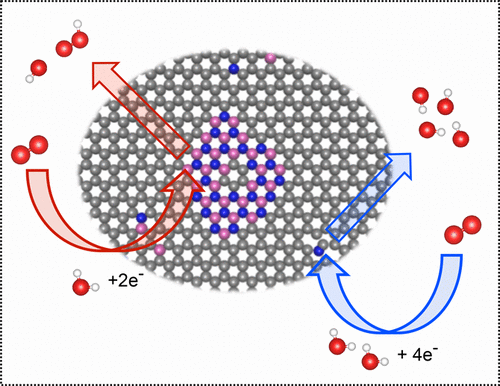当前位置:
X-MOL 学术
›
J. Am. Chem. Soc.
›
论文详情
Our official English website, www.x-mol.net, welcomes your
feedback! (Note: you will need to create a separate account there.)
Designing Boron Nitride Islands in Carbon Materials for Efficient Electrochemical Synthesis of Hydrogen Peroxide
Journal of the American Chemical Society ( IF 14.4 ) Pub Date : 2018-06-06 , DOI: 10.1021/jacs.8b02798 Shucheng Chen 1 , Zhihua Chen 1 , Samira Siahrostami 1 , Drew Higgins 1 , Dennis Nordlund 2 , Dimosthenis Sokaras 2 , Taeho Roy Kim 3 , Yunzhi Liu 3 , Xuzhou Yan 1 , Elisabeth Nilsson 4 , Robert Sinclair 3 , Jens K. Nørskov 1, 4 , Thomas F. Jaramillo 1, 4 , Zhenan Bao 1
Journal of the American Chemical Society ( IF 14.4 ) Pub Date : 2018-06-06 , DOI: 10.1021/jacs.8b02798 Shucheng Chen 1 , Zhihua Chen 1 , Samira Siahrostami 1 , Drew Higgins 1 , Dennis Nordlund 2 , Dimosthenis Sokaras 2 , Taeho Roy Kim 3 , Yunzhi Liu 3 , Xuzhou Yan 1 , Elisabeth Nilsson 4 , Robert Sinclair 3 , Jens K. Nørskov 1, 4 , Thomas F. Jaramillo 1, 4 , Zhenan Bao 1
Affiliation

|
Heteroatom-doped carbons have drawn increasing research interest as catalysts for various electrochemical reactions due to their unique electronic and surface structures. In particular, co-doping of carbon with boron and nitrogen has been shown to provide significant catalytic activity for oxygen reduction reaction (ORR). However, limited experimental work has been done to systematically study these materials, and much remains to be understood about the nature of the active site(s), particularly with regards to the factors underlying the activity enhancements of these boron-carbon-nitrogen (BCN) materials. Herein, we prepare several BCN materials experimentally with a facile and controlled synthesis method, and systematically study their electrochemical performance. We demonstrate the existence of h-BN domains embedded in the graphitic structures of these materials using X-ray spectroscopy. These synthesized structures yield higher activity and selectivity toward the 2e- ORR to H2O2 than structures with individual B or N doping. We further employ density functional theory calculations to understand the role of a variety of h-BN domains within the carbon lattice for the ORR and find that the interface between h-BN domains and graphene exhibits unique catalytic behavior that can preferentially drive the production of H2O2. To the best of our knowledge, this is the first example of h-BN domains in carbon identified as a novel system for the electrochemical production of H2O2.
中文翻译:

设计用于高效电化学合成过氧化氢的碳材料中的氮化硼岛
由于其独特的电子和表面结构,杂原子掺杂的碳作为各种电化学反应的催化剂引起了越来越多的研究兴趣。特别是,碳与硼和氮的共掺杂已被证明为氧还原反应 (ORR) 提供了显着的催化活性。然而,系统研究这些材料的实验工作有限,关于活性位点的性质还有很多有待了解,特别是关于这些硼 - 碳 - 氮(BCN)活性增强的潜在因素) 材料。在此,我们用一种简便可控的合成方法通过实验制备了几种 BCN 材料,并系统地研究了它们的电化学性能。我们使用 X 射线光谱证明了嵌入这些材料的石墨结构中的 h-BN 域的存在。与具有单独 B 或 N 掺杂的结构相比,这些合成结构对 H2O2 的 2e-ORR 产生更高的活性和选择性。我们进一步采用密度泛函理论计算来理解碳晶格内各种 h-BN 域对 ORR 的作用,并发现 h-BN 域和石墨烯之间的界面表现出独特的催化行为,可以优先驱动 H2O2 的产生. 据我们所知,这是碳中 h-BN 域的第一个例子,被认为是一种用于电化学生产 H2O2 的新型系统。与具有单独 B 或 N 掺杂的结构相比,这些合成结构对 H2O2 的 2e-ORR 产生更高的活性和选择性。我们进一步采用密度泛函理论计算来理解碳晶格内各种 h-BN 域对 ORR 的作用,并发现 h-BN 域和石墨烯之间的界面表现出独特的催化行为,可以优先驱动 H2O2 的产生. 据我们所知,这是碳中 h-BN 域的第一个例子,被认为是一种用于电化学生产 H2O2 的新型系统。与具有单独 B 或 N 掺杂的结构相比,这些合成结构对 H2O2 的 2e-ORR 产生更高的活性和选择性。我们进一步采用密度泛函理论计算来理解碳晶格内各种 h-BN 域对 ORR 的作用,并发现 h-BN 域和石墨烯之间的界面表现出独特的催化行为,可以优先驱动 H2O2 的产生. 据我们所知,这是碳中 h-BN 域的第一个例子,被认为是一种用于电化学生产 H2O2 的新型系统。我们进一步采用密度泛函理论计算来理解碳晶格内各种 h-BN 域对 ORR 的作用,并发现 h-BN 域和石墨烯之间的界面表现出独特的催化行为,可以优先驱动 H2O2 的产生. 据我们所知,这是碳中 h-BN 域的第一个例子,被认为是一种用于电化学生产 H2O2 的新型系统。我们进一步采用密度泛函理论计算来理解碳晶格内各种 h-BN 域对 ORR 的作用,并发现 h-BN 域和石墨烯之间的界面表现出独特的催化行为,可以优先驱动 H2O2 的产生. 据我们所知,这是碳中 h-BN 域的第一个例子,被认为是一种用于电化学生产 H2O2 的新型系统。
更新日期:2018-06-06
中文翻译:

设计用于高效电化学合成过氧化氢的碳材料中的氮化硼岛
由于其独特的电子和表面结构,杂原子掺杂的碳作为各种电化学反应的催化剂引起了越来越多的研究兴趣。特别是,碳与硼和氮的共掺杂已被证明为氧还原反应 (ORR) 提供了显着的催化活性。然而,系统研究这些材料的实验工作有限,关于活性位点的性质还有很多有待了解,特别是关于这些硼 - 碳 - 氮(BCN)活性增强的潜在因素) 材料。在此,我们用一种简便可控的合成方法通过实验制备了几种 BCN 材料,并系统地研究了它们的电化学性能。我们使用 X 射线光谱证明了嵌入这些材料的石墨结构中的 h-BN 域的存在。与具有单独 B 或 N 掺杂的结构相比,这些合成结构对 H2O2 的 2e-ORR 产生更高的活性和选择性。我们进一步采用密度泛函理论计算来理解碳晶格内各种 h-BN 域对 ORR 的作用,并发现 h-BN 域和石墨烯之间的界面表现出独特的催化行为,可以优先驱动 H2O2 的产生. 据我们所知,这是碳中 h-BN 域的第一个例子,被认为是一种用于电化学生产 H2O2 的新型系统。与具有单独 B 或 N 掺杂的结构相比,这些合成结构对 H2O2 的 2e-ORR 产生更高的活性和选择性。我们进一步采用密度泛函理论计算来理解碳晶格内各种 h-BN 域对 ORR 的作用,并发现 h-BN 域和石墨烯之间的界面表现出独特的催化行为,可以优先驱动 H2O2 的产生. 据我们所知,这是碳中 h-BN 域的第一个例子,被认为是一种用于电化学生产 H2O2 的新型系统。与具有单独 B 或 N 掺杂的结构相比,这些合成结构对 H2O2 的 2e-ORR 产生更高的活性和选择性。我们进一步采用密度泛函理论计算来理解碳晶格内各种 h-BN 域对 ORR 的作用,并发现 h-BN 域和石墨烯之间的界面表现出独特的催化行为,可以优先驱动 H2O2 的产生. 据我们所知,这是碳中 h-BN 域的第一个例子,被认为是一种用于电化学生产 H2O2 的新型系统。我们进一步采用密度泛函理论计算来理解碳晶格内各种 h-BN 域对 ORR 的作用,并发现 h-BN 域和石墨烯之间的界面表现出独特的催化行为,可以优先驱动 H2O2 的产生. 据我们所知,这是碳中 h-BN 域的第一个例子,被认为是一种用于电化学生产 H2O2 的新型系统。我们进一步采用密度泛函理论计算来理解碳晶格内各种 h-BN 域对 ORR 的作用,并发现 h-BN 域和石墨烯之间的界面表现出独特的催化行为,可以优先驱动 H2O2 的产生. 据我们所知,这是碳中 h-BN 域的第一个例子,被认为是一种用于电化学生产 H2O2 的新型系统。











































 京公网安备 11010802027423号
京公网安备 11010802027423号